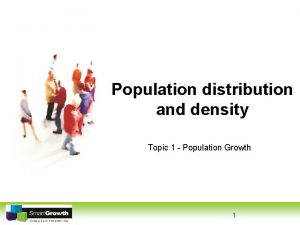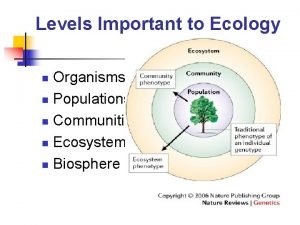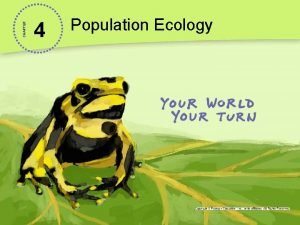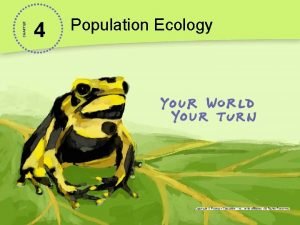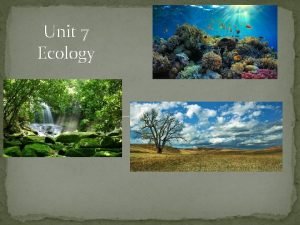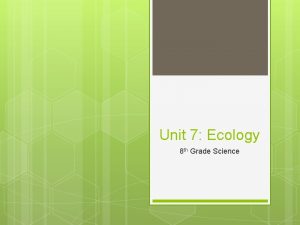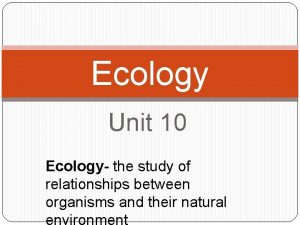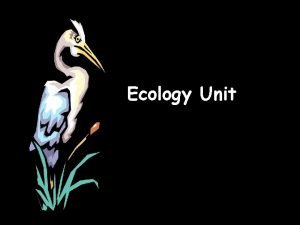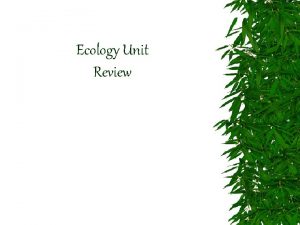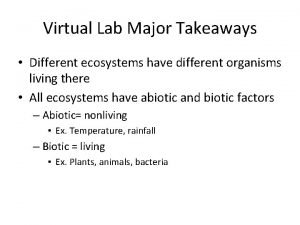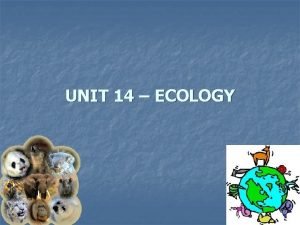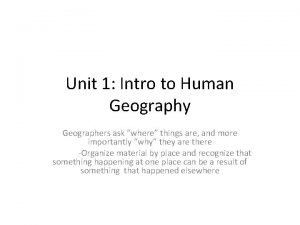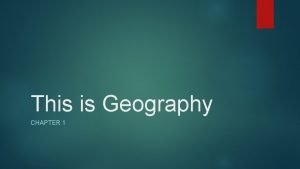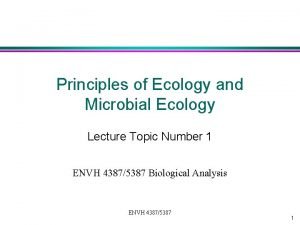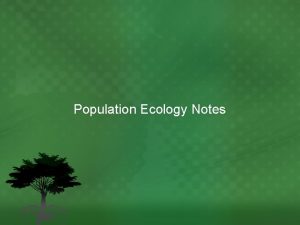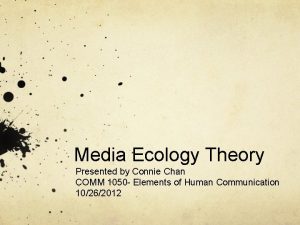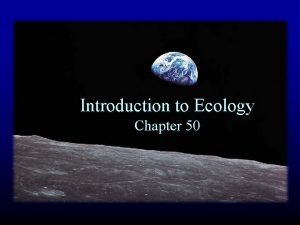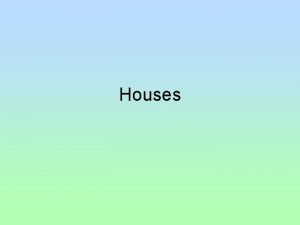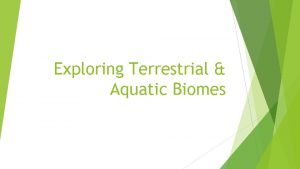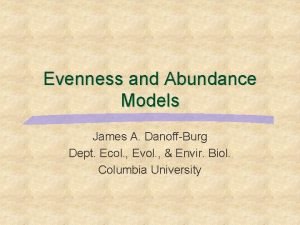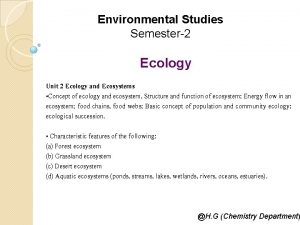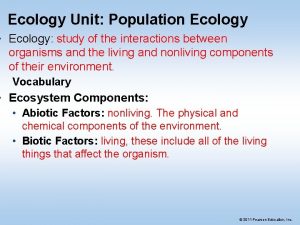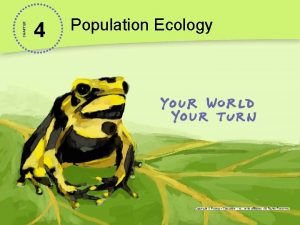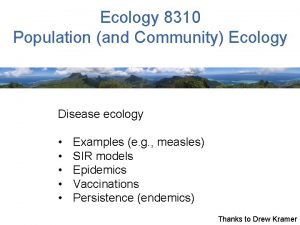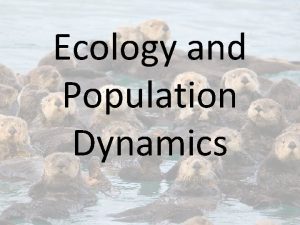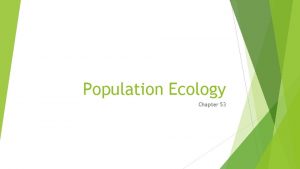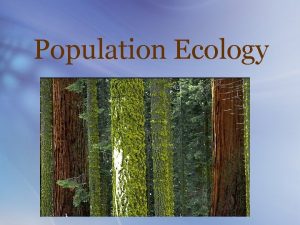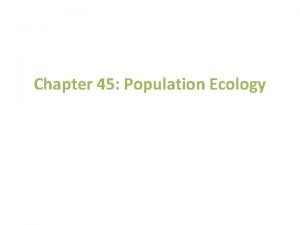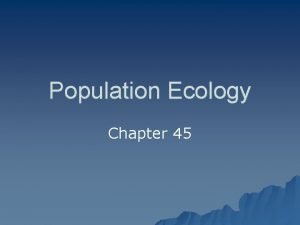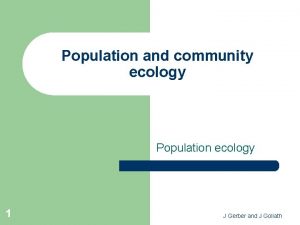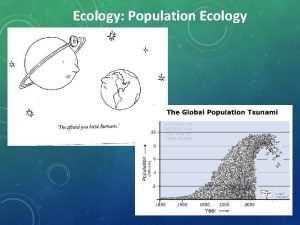Unit 3 Population Ecology Finding Gold in a
















































- Slides: 48

Unit 3: Population Ecology

Finding Gold in a Costa Rican Cloud Forest • Golden toads lived in Costa Rica’s Monteverde cloud forest. • Golden toads were first described in 1964. They were extinct by 1989. Talk About It Why is the extinction of the golden toad a global concern?

Lesson 4. 1 Studying Ecology

Lesson 4. 1 Studying Ecology Levels of Ecological Organization ECOLOGY • _________ - The study of how organisms interact with each other and with their environments • Scientists study ecology at various levels of organization. Individual Population Community Ecosystem Biosphere

Lesson 4. 1 Studying Ecology Levels of Ecological Organization INDIVIDUAL • _________ - One organism Individual Population Community Ecosystem Biosphere

Lesson 4. 1 Studying Ecology Levels of Ecological Organization POPULATION • __________ - members of a species that live in the same area at the same time SPECIES - a group of individuals that interbreed and • _________ produce fertile offspring • Population Ecology is the study of how individuals within a population interact with one another Individual Population Community Ecosystem Biosphere

Lesson 4. 1 Studying Ecology Levels of Ecological Organization COMMUNITY • __________ - All of the populations in a particular area • Community Ecology is the study of interactions between species Individual Population Community Ecosystem Biosphere

Lesson 4. 1 Studying Ecology Levels of Ecological Organization ECOSYSTEM • __________ - Includes all of the living things and nonliving things in a particular area • Ecosystem Ecology is the study of the living and nonliving components of a system together Individual Population Community Ecosystem Biosphere

Lesson 4. 1 Studying Ecology Levels of Ecological Organization BIOSPHERE • __________ - All parts of Earth that host life, with all its organisms and environments Individual Population Community Ecosystem Biosphere

Lesson 4. 1 Studying Ecology Biotic and Abiotic Factors BIOTIC • ______ factors: Parts of an ecosystem that are ______ or used to be living LIVING • Examples: • Plants • Animals • Fungus • Bacteria Did You Know? Decaying organisms are biotic factors as long as their structure remains cellular.

Lesson 4. 1 Studying Ecology Biotic and Abiotic Factors ABIOTIC • ________ factors: Parts of an ecosystem that have never been living • Examples: • Sun (Sunlight) • Oxygen • Water • Rocks • Temperature • Wind • p. H

Lesson 4. 1 Studying Ecology Habitat • _______ -The specific environment in which an organism lives • Includes biotic and abiotic factors ORGANISM • Boundaries are defined by the particular ________ that lives there • Earthworm vs. Hawk

Lesson 4. 1 Studying Ecology Habitat RESOURCES • Habitats provide an organism with __________ —anything an organism needs to survive and reproduce, including food, shelter, and mates.

Lesson 4. 2 Describing Populations From 1900 to 2000, the white-tailed deer population of New York state grew from about 20, 000 to more than 1 million. Densities of more than 100 deer per sq mi occur in some metropolitan areas.

Lesson 4. 2 Describing Populations Population • What is a population again? • SPECIES Members of the same _______ that live in AREA TIME the same ______ at the same _______ • Population ecology studies how members of the population interact with one another

Lesson 4. 2 Describing Populations Population Size NUMBER • Population Size -The _______ of individuals in a population at a given time • When population size __________ or remains ______, it is a sign that the population is healthy • Sudden and dramatic __________ in population size can indicate an unhealthy population headed toward extinction. • Ex. Golden Toads • 1987 – 1500 toads • 1988 – 10 toads • 1989 – 1 toad • 1990 – no toads STEADY INCREASES DECREASES

Lesson 4. 2 Describing Populations Population Size • The Decline of the Passenger Pigeon • Once the most abundant bird in North America • In the early 1880 s a scientist described a flock of 2 billion birds that covered 240 miles of sky, took 5 hours to pass overhead and sounded like a tornado! • Then, due to deforestation and hunting, the population slowly dwindled away with the last one dying in 1914

Lesson 4. 2 Describing Populations Population Size SAMPLING • Ecologists often use ________ techniques to estimate population size. • Count organisms in a ________ sample area and use it to estimate how many there are in the larger overall area SMALLER • Ex. If there are 100 oak trees in one square km, it would be reasonable to estimate that there are _____ in ten square kms 1000 Counting Laysan Albatross Nests

Lesson 4. 2 Describing Populations Population Size • What if what you are counting doesn’t stay still? MARK & RECAPTURE • Use the “________________” Technique • Catch organisms, tag them, release them • Catch another sample of organisms • Assume that the number of marked organism that are recaptured in the sample is proportionate to the number of marked organisms in the whole population • # marked in sample = # marked in total population ____# in sample # population

Lesson 4. 2 Describing Populations Population Size • Ex. Suppose you capture and mark 20 turtles at a pond. After releasing these turtles, you return a few days later and catch 10 turtles. Of these 10 turtles, 5 are already marked. How many turtles are in the total population? • # marked in sample = # marked in total population ____# in sample # population • 5 = 10 • 5*? = (20)*(10) • 5*? = 200 • ? (# population) = 40 20 ?

Lesson 4. 2 Describing Populations Population Density • Measure of how ________ a population is (number of individuals within a population per unit area CROWDED • Ex. If 1500 golden toads were found within 4 square kilometers, the population density would be _____ or _______ toads/square km. 375 1500/4 • Larger organisms generally have lower population densities (ex. Lions).

Lesson 4. 2 Describing Populations Population Density LOW • ____ population density: More space and resources but finding mates can be difficult

Finding a mate can be difficult with a low population density

Lesson 4. 2 Describing Populations Population Density HIGH • _____ population density: Finding mates is easier but there tends to be more __________, more infectious _______, & more vulnerability to predators COMPETITION DISEASE • Ex. Harlequin Frog Northern pintail ducks

Lesson 4. 2 Describing Populations Population Distribution ARRANGED • How organisms are _________ within an area: RANDOM 1) ________ distribution: Organisms arranged in no particular pattern • Resources are found ___________ the area and others organisms do not influence where members of the population settle THROUGHOUT

Lesson 4. 2 Describing Populations Population Distribution UNIFORM 2) ________ distribution: Organisms evenly spaced • Individuals hold territories or ________ for space COMPETE

Lesson 4. 2 Describing Populations Population Distribution CLUMPED 3) ________ distribution: Organisms grouped near __________ • RESOURCES MOST COMMON _____________ distribution in nature

Lesson 4. 2 Describing Populations Age Structure NUMBER • Age Structure Diagram - Relative ________ of organisms of each ____ group within population displayed in a pyramid AGE GROWTH • Can be used to predict future population ________

Lesson 4. 2 Describing Populations Age Structure • Three Main Types of Populations STABLE 1) ________ - Even distribution of ages (births keep pace with deaths) DECLINING ________ - Mostly younger GROWING 2) _________ - Mostly older individuals 3)

Lesson 4. 2 Describing Populations Age Structure

Lesson 4. 2 Describing Populations Sex Ratios MALES FEMALES • Proportion of _______ to ________ • Age structure diagrams give information about sex ratios. 50: 50 • For a monogamous species, the ideal sex ratio is _____. • Why?

Lesson 4. 3 Population Growth From 1800 to today, the human population has grown from about 1 billion to more than 6. 8 billion—an exponential rate of increase.

Lesson 4. 3 Population Growth • A few bacteria can multiply to millions in hours • A few whales must have at least a year to produce just one baby. • Why? ?

Lesson 4. 3 Population Growth • Factors That Determine Population Growth 1)Births and Deaths 2)Immigration and Emigration

Lesson 4. 3 Population Growth Birth and Death Rates • A population’s relative birth and death rates (mortality and natality) affect how it ________. GROWS DENSITY distribution, sex ratio • Population size, _______, and _______ AGE __________ STRUCTURE all influence how many are born and how many die. • If everything else is equal, when a populations birthrate is greater than their death rate, the population ________. INCREASES

Lesson 4. 3 Population Growth Birth and Death Rates • Survivorship curves show the likelihood of death varies with age. • Type I – Higher mortality rate at an OLDER _____ ages Ex. Humans • Type II -EQUAL _____ mortality at all ages Ex. Most birds • Type III – Higher mortality rate at _______ YOUNGER ages Ex. Golden Toad

Lesson 4. 3 Population Growth Immigration and Emigration • In addition to births and deaths, population growth is affected by immigration and emigration ARRIVAL of individuals from outside • Immigration – _______ a give area IN • Emigration - DEPARTURE ________ of individuals from a given area EXIT

Lesson 4. 3 Population Growth Immigration and Emigration • MIGRATION ________ seasonal movement into and out of an area, can temporarily affect population size.

Lesson 4. 3 Population Growth Calculating Population Growth • Determined by the following equation: a (individuals added) – (individuals subtracted) or. . Birthrate Immigration rate) (_________ + _________ - Emigration rate) Death rate + ________ (________ Positive growth rate; • Growing populations have a ______ Negative growth rate. shrinking populations have a _______ • Usually expressed in terms of individuals per 1000

Lesson 4. 3 Population Growth Calculating Population Growth

Lesson 4. 3 Population Growth Calculating Population Growth rate 100 -100 49 -180 -100 98 100

Lesson 4. 3 Population Growth How Populations Grow GROWTH • EXPONENTIAL _________ Population increases by a fixed percentage every year. • Normally occurs only when small populations are introduced to an area with _____ IDEAL environmental conditions • Rarely lasts long

Lesson 4. 3 Population Growth How Populations Grow LOGISTIC GROWTH • ______ Describes how a populations initial exponential growth is slowed and finally stopped by limiting factors • Limiting factors are characteristics of the environment that ____ LIMIT population growth

Lesson 4. 3 Population Growth How Populations Grow • 2 Types of Limiting factors: • Density-dependent: Influence changes with population density. Ex. Food, _____, WATER Space, ______, DISEASE Predation • Density-independent: Influence does ______change with NOT population density. DISASTERS Ex. Natural _______, Climate Change

Lesson 4. 3 Population Growth How Populations Grow • Density Dependent or Density Independent? D Due to severe overcrowding in an Asian village, many _____ children do not survive to reach adulthood. I The eruption of Mt. St. Helens destroys most of the _____ wildlife in the immediate vicinity of the volcano D Due to lack of food and nutrition, large numbers of _____ female mice miscarry their young and fail to reproduce

Lesson 4. 3 Population Growth How Populations Grow • Limiting Factors determine a population’s carrying capacity. • Carrying Capacity – the LARGEST population an _______ environment can sustainably support. • It can change as limiting factors in the environment change

Lesson 4. 3 Population Growth Biotic Potential • Limiting Factors are only part of the story. . We also have to look at the characteristics of the organism • An organism’s ______ MAXIMUM ability to produce offspring in ideal conditions is called _____ BIOTIC ________ POTENTIAL • Two main things influence biotic potential: • 1) GESTATION _______ time – how long it takes for an embryo to develop and “be born” • 2) GENERATION ________ time – the span from an organism’s birth to the time is has its own offspring. HIGH biotic potential can recover more • Organisms with ____________ QUICKLY from population declines than organisms with low biotic potential.

Lesson 4. 3 Population Growth Biotic Potential Scorpion Fish vs. Orangutan Scorpion Fish – Sexually mature at age 3 -5, they lay 50, 000 to 100, 000 eggs a year and they only take 12 to 16 days to hatch Orangutan – Sexually mature at age 10, they give birth to a single baby only once about every 8 years Which organism has the higher biotic potential? Scorpion Fish
 Chapter 4 population ecology answer key
Chapter 4 population ecology answer key Section 1 population dynamics answer key
Section 1 population dynamics answer key Population ecology section 1 population dynamics
Population ecology section 1 population dynamics Section 1 population dynamics answer key
Section 1 population dynamics answer key Population ecology example
Population ecology example Exponential growth definition biology
Exponential growth definition biology Population vs community ecology
Population vs community ecology Ecosystem vs community
Ecosystem vs community Concept 3 population ecology
Concept 3 population ecology Chapter 53 population ecology
Chapter 53 population ecology Chapter 36 population ecology
Chapter 36 population ecology Ecology
Ecology Population ecology def
Population ecology def Chapter 53 population ecology
Chapter 53 population ecology Population characteristic
Population characteristic Section 1 population dynamics answer key
Section 1 population dynamics answer key Population characteristics ecology
Population characteristics ecology What is population ecology
What is population ecology Population definition ecology
Population definition ecology Population ecology
Population ecology Parasitism pictures
Parasitism pictures Chapter 53 population ecology
Chapter 53 population ecology Finding gold in a costa rican cloud forest
Finding gold in a costa rican cloud forest Finding gold in a costa rican cloud forest
Finding gold in a costa rican cloud forest Cycle of carbon
Cycle of carbon Unit 7 ecology answer key
Unit 7 ecology answer key Which of the following tells you population density
Which of the following tells you population density Unit 10 ecology
Unit 10 ecology Ecology unit review
Ecology unit review Sulfur oxide
Sulfur oxide Unit 10, unit 10 review tests, unit 10 general test
Unit 10, unit 10 review tests, unit 10 general test Ecology webquest answers
Ecology webquest answers Ecology virtual lab
Ecology virtual lab Biotic community is another name for____
Biotic community is another name for____ Cultural ecology ap human geography
Cultural ecology ap human geography 3 pillars of sustainability ap human geography
3 pillars of sustainability ap human geography Environment vs ecology
Environment vs ecology Ernst haeckel ecology
Ernst haeckel ecology Stable community
Stable community Niche definition biology
Niche definition biology Biotic potential and environmental resistance
Biotic potential and environmental resistance Mind map about media and information literacy
Mind map about media and information literacy Media ecology theory
Media ecology theory Tropical grassland
Tropical grassland Chapter 52 an introduction to ecology and the biosphere
Chapter 52 an introduction to ecology and the biosphere Folk houses
Folk houses Organismal ecology
Organismal ecology Rank abundance curve excel
Rank abundance curve excel Difference between ecosystem and ecology
Difference between ecosystem and ecology



















